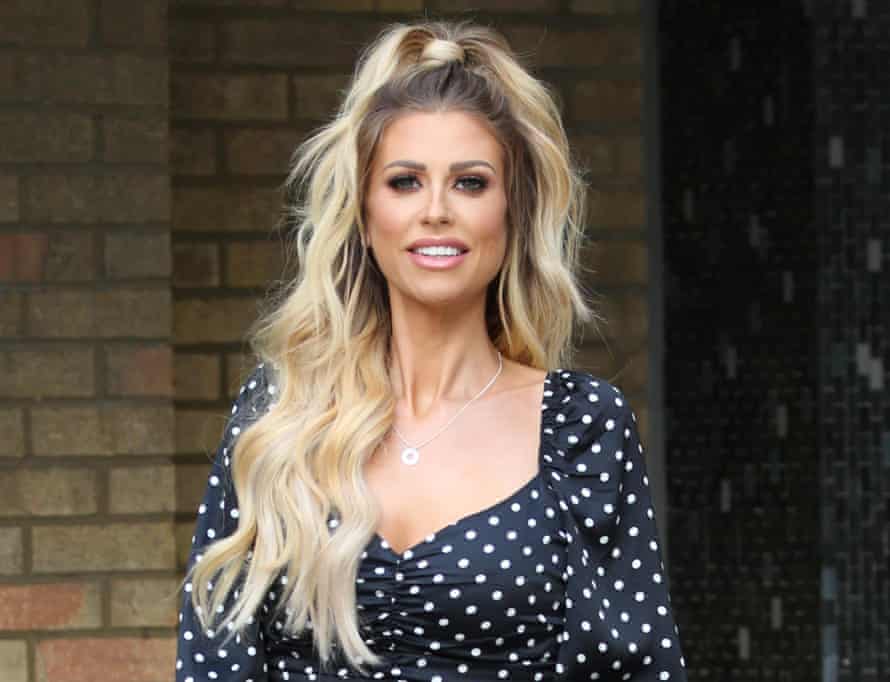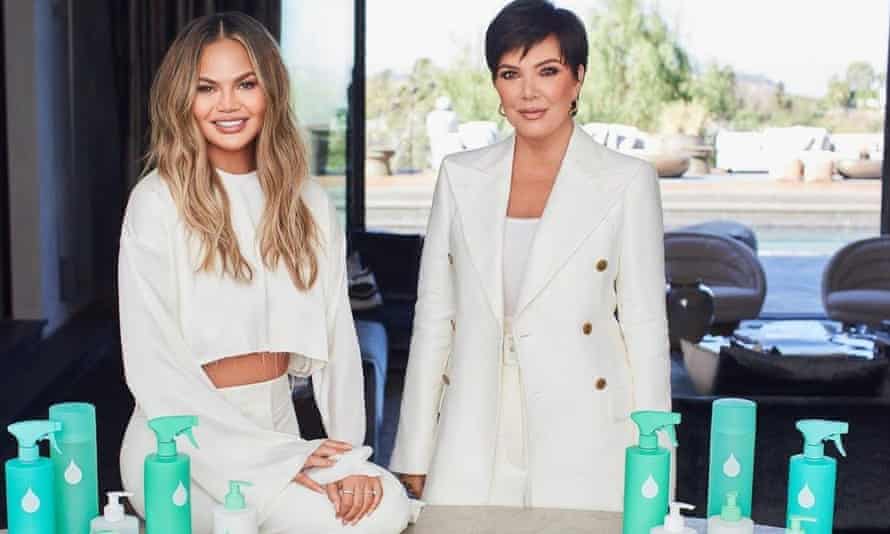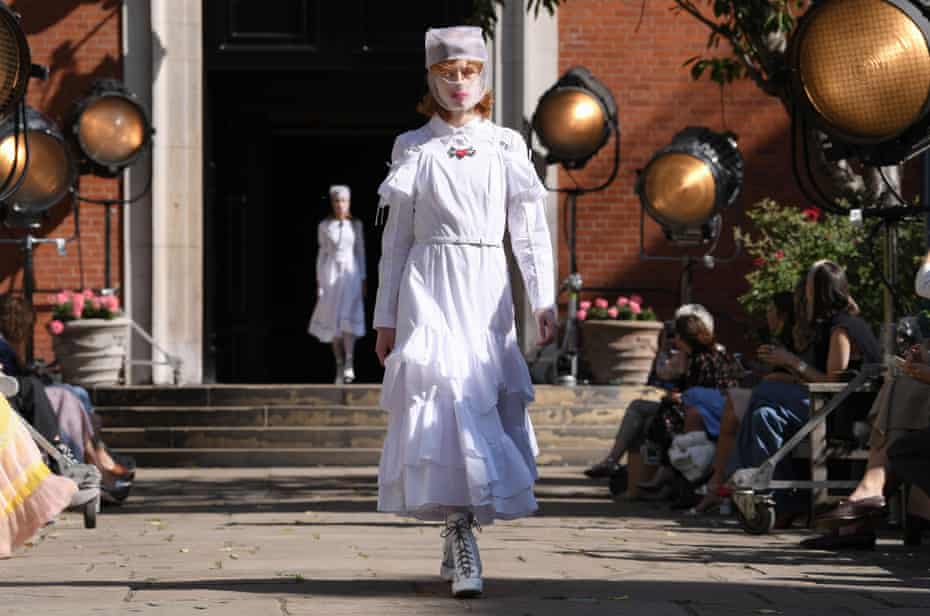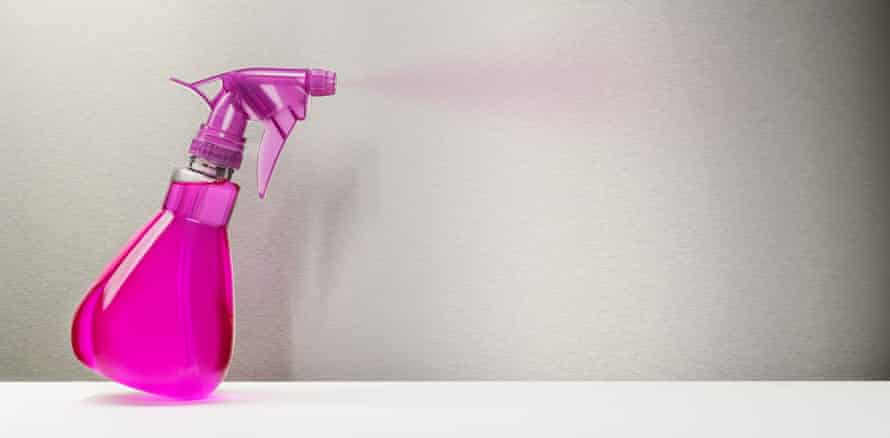Before Lynsey Crombie sits on a train, or outside a cafe, she takes out her antibacterial wipes and cleans the table, the arms of her seat – anywhere she might touch or put her phone down. “I’ve always done it,” says the bestselling author of The 15-Minute Clean and How To Clean Your House And Tidy Up Your Life. “Until last year I used to get some funny looks.”
These days there are no funny looks, the pandemic having made germophobes of many of us. Between March and May of 2020, UK sales of liquid disinfectant were 74.9% higher, and bleach 32% higher, than the year before. Until the vaccine came along, hygiene seemed to be our best defence against a deadly enemy that threatened our entire way of life, and we diligently held that line. What did you do in the war effort, Mummy? I triple-sanitised the door handle, darling.
Cleanliness is once again up there next to godliness, as the Victorian embroidery samplers proclaimed. Or is cleaning the new rock’n’roll? (After all, bleach even found itself at the centre of a global scandal last April, when the then President Trump wondered aloud about shooting it directly into his veins as a cure for Covid-19.) A flair for cleaning can now launch a showbiz career as effectively as a talent for singing or cooking: Loose Women panellist Stacey Solomon has a breakout new solo BBC show, Sort Your Life Out, showcasing her home organisation skills and cleaning tips. Sophie Hinchcliffe, AKA Mrs Hinch, has four million Instagram followers captivated by her winning combination of long-lashed glamour and nifty cleaning tricks. At 30, she has already published four No 1 bestselling books; her first, Hinch Yourself Happy, combining memoir and tips, became the second fastest-selling non-fiction title of all time. Get Organized with The Home Edit, which deftly repackages housework as entertainment, was a surprise Netflix hit last year.

With vanilla-blond hair and a taste for pink jumpsuits, Crombie, Instagram’s “Queen of Clean”, is an upbeat cheerleader for cleaning 2.0. On the cover of her latest book she even holds a fluffy duster aloft like a pompom. But she knows from her own deeply painful experience that the impulse to clean can be about more than hygiene. Eighteen years ago, a police officer knocked at her front door, bringing the bombshell news that her new husband was under arrest for paedophilia offences. Crombie went into premature labour with the twins she was carrying, and overnight became a single mother to two babies in intensive care. She began to clean obsessively: scrubbing her arms and marital bed with bleach. “I was literally scrubbing away the pain and the anger,” she says now. “I tried counselling, but the only time I felt normal was when I was cleaning. Some people turn to exercise or to alcohol – I turned to mops and buckets.”
There is perhaps a droplet of Crombie’s story in our collective new love of cleaning. Cleaning is our society dealing with the trauma of the last year in what feels like a constructive way. It is a semi-logical coping mechanism as we struggle to regain control over an environment that turned against us so suddenly. But cleaning isn’t always as wholesome as it seems. In fact, our obsession with cleanliness might be toxic.
The pandemic “has 100% impacted on standards of cleanliness”, says Lindsay Goddard, a technician who services homes and offices with ICE Cleaning. His clients “want a higher level of cleaning, and they care about the kind of cleaning you can’t see. It’s not uncommon now to get requests for surface bacterial readings; I used to carry one box of those swabs in my van, now I carry five.” There was undoubtedly room for improvement, since research in 2019 showed that only 49% of British people washed their hands after using a public bathroom. Jamie Woodhall, technical and innovation manager of Rentokil, says, “Anecdotally, that seems to have changed.” He adds, “A year ago, terms like ‘anti-viral’ were in small print on the back of cleaning product bottles – now they are on the television, so people are much more aware.”
James Hamblin, the science writer and author of Clean: The New Science of Skin believes, “We are going to think more about the things we should have been doing all along. Hundreds of thousands of people die every year from influenza, the spread of which is preventable by the same means the last year has taught us about.” A corporate culture of presenteeism, which until last year made it acceptable (admirable, even) to show up in an office shivering and sneezing, ploughing through deadlines with tissues piling up by the keyboard, is likely to shift towards a culture that encourages workers to keep their germs at home.
Meanwhile, at the other end of the seesaw, cleanliness is elevated into a luxury label. It becomes a status-signifier, a lifestyle choice. Chrissy Teigen and Kris Jenner – two titans of American pop culture, whose family homes provide the stage set for Instagram followings of 34 million and 40 million respectively – recently launched Safely, a range of plant-based domestic cleaning products whose sleek, pistachio-green packaging is more hotel-bathroom than under-the-kitchen-sink. The scents are of firewood and lemongrass, like expensive scented candles. Teigen’s first Instagram post promoting Safely showed her perched on a kitchen worktop in a feather-trimmed gown and heeled crystal sandals, brandishing a spray bottle of Safely in one manicured hand, as if about to spritz herself with fragrance. “Dirty mouth, clean house!!!!” ran the caption. It was a tongue-in-cheek pantomime of domesticity, but based on a real market opportunity. (Sales figures for Safely are not yet available, but few would question the business instincts of Jenner, matriarch of the Kardashian industry.)

The pandemic turbo-charged a fetishisation of “clean” that was already in motion. “My book was written before the pandemic, and ‘clean’ had already got to this kind of meta-level,” says Hamblin. “Hygiene is about stopping the spread of disease, but cleanliness is a social construct.” He points out that cleanliness in our culture is a concept that pre-dates germ theory, “an ethereal notion associated with purity and ritual that doesn’t have a clear definition”. “Dirty” jokes are not unhygienic; “clean” eating has nothing to do with disease. But because germs are invisible, “we look for clues in other places and end up taking how things look or smell as a signifier of threat, and that has all kinds of impact on our culture,” says Hamblin. “Clean has a problematic history as a concept. It has associations with virginity, with societal notions of ‘purity’. It is insidious and judgmental – it means nothing, and at the same time it means a lot.”
In the 21st-century religion that is Wellness, clean has become the highest and most flexible of accolades. Clean beauty products are made without certain chemicals. Clean eating avoids certain food groups. Clean sleeping involves yin yoga and leaving your phone in another room. The logic is, to put it kindly, woolly. In this ecosystem, where Mother Nature has been replaced by the blond radiance of Gwyneth Paltrow, “clean” is a synonym for “disciplined”, or sometimes “perfect”. The quest for wellness, as the New York writer Fran Lebowitz observed, “is a kind of greediness. It’s not enough not to be sick. Now they want to be extra well.”
The buzz around clean started growing towards the end of the last decade. Crombie was inspired to turn what she calls her “rage cleaning” into a career after reading about fashion bloggers who were making a living from Instagram posts. “People liked looking at my pictures, too. I saw there was a gap in the market.” In 2019, a few months after Crombie’s first book was published, supermodel Naomi Campbell went viral with a video blog in which she demonstrated what she called her “seat thing”. Boarding a plane, she snapped on latex gloves and cleaned her seat, table and in-flight entertainment system with a pack of Dettol wipes. The juxtaposition of Campbell’s forensic cleaning routine with the trappings of her luxury lifestyle (her silk Burberry pyjamas and well-appointed flat-bed seat in first class) framed cleaning in a new context. The video has been watched three million times on YouTube. But it was in 2020 that cleaning “really got trendy”, as Crombie puts it: “People who were furloughed were opening cupboards they hadn’t opened for years, and getting such satisfaction from cleaning them out. People were finding things they had forgotten all about. It happened to me – I found an iPad I thought I’d left on a plane.”
Living with the threat of Covid has changed our priorities when we clean our homes, as well as how thoroughly we do it. In the early days of the pandemic, when surface transmission was thought to be a more central concern than it subsequently turned out to be, there was a frenzy of decluttering, as we strove for clear, easy-to-clean surfaces. We learned to focus on touch points (light switches, kettle handles, fridge doors) rather than obsessing over cobwebs in ceiling corners. More recently, fear of virus particles hanging in the air has changed things again. “Air treatments used to be something we would do if we discovered mould, but now clients are asking for them, to clean the air,” says Goddard. As for office cleaning, “It often used to be a box-tick,” he says. “Cleaning the toilets and emptying the bins. That’s absolutely not good enough any more.” Transport for London is trialling continuous UV cleaning of escalator handrails in tube stations, and reassuring nervous returning commuters that its cleaning team are “using long-lasting hospital-grade cleaning substances that kill viruses and bacteria on contact”.

Just as the trend for informal socialising long ago changed the layout of our homes, ushering in the age of the open-plan kitchen-diner as the mark of an aspirational home, so this shift in priorities is starting to change our interiors. The home website houzz.co.uk reports a spike in “white kitchen” as a search term, “perhaps reflecting a pandemic-fuelled desire for clean-looking cooking spaces”. The tap manufacturer Grohe has seen a rise in orders for touch-free taps with infrared technology. A second sink for hand-washing, often found in restaurant kitchens so staff can lather up their hands away from food preparation areas, is beginning to find its way into aspirational kitchen design. Naomi Astley Clarke, an interior designer, has noticed clients requesting dedicated hallway space for guests to remove shoes, and a preference for a pile of individual small cloths next to a washbasin, to be dropped directly into a laundry basket, over the traditional hand towel. A recent client changed her mind about fabric doors on a built-in closet, in favour of mirrored ones. “People want things spick and span,” she says.
Our attitude to dirt is irrational. The human body is full of germs. In fact, according to microbiologist Lynn Bry, assistant professor at Harvard Medical School, “If you were germ-free this moment, you’d be dead within two weeks.” Bacteria are essential for our immune systems, and to enable us to break down food and extract the nutrients we need. Hamblin’s book opens with the deliberately provocative confession that he stopped showering for five years. Hamblin, a lecturer at Yale School of Public Health, says, “There is no health reason to wash your body with soap every day.” (He never stopped washing his hands, and occasionally got his hair wet, but used neither shampoo nor shower gel. In his book he writes, “I am under no illusions that I never smelled bad. But it happened less and less regularly.”) “Two centuries of marketing campaigns have melded hygiene and cleanliness, in our minds,” he says. It was the manufacturers of deodorant and mouthwash and fabric softener, not doctors, who taught us that minty-fresh equals healthy.
Hamblin hopes that the pandemic “will make us realise that we need to think more clearly about this stuff. What matters [with Covid] is how far you stand from someone, not how they look or whether they smell great.” In a world where optics are all, hygiene and disease are a challenge. You can’t see virus particles. You can’t see whether someone has had a vaccine. He says: “Being perceived to be clean is going to be a charged issue, as we come out of this. Say you see a person who smells good, who is wearing a nice suit, who has their hair freshly cut – if they are coughing, then they are the threat, not the person who hasn’t had a shower today because they are homeless.”

After clean eating, clean beauty and clean sleeping, next up is clean fashion. One of the few fashion shows I have attended in person since the pandemic began was by the Turkish-born, London-based designer Bora Aksu, held in the rose-bowered churchyard of St Paul’s Church in Covent Garden, London, last September. The sparse audience were socially distanced by means of individual wooden park benches, from which we practised smizing over our masks in lieu of the traditional air kisses. The first model emerged through the church door wearing a starched white cotton apron, tiered and belted, over a neatly buttoned white shirt. Her hair was freshly tonged under a wisp of a nurse’s cap, her lipstick a shock of pink under a matching sheer face mask. The next model wore the same cap and veil, and a pocketed apron over her bib-fronted all-white dress. The boots were sturdy lace-ups, in white, worn with prim white tights with embroidered Swiss dots. The message was of thanks and homage to health workers, but there was something else, too: an elevation of nurse-station signifiers of cleanliness and purity to catwalk status.
Fashion is feeling its way, bruised and battle-scarred, out of a pandemic that has battered its profits and its confidence. For now, comfort (read: sweatpants, pyjamas, knitwear) reigns supreme, because that is what is still selling most reliably and few brands are in a financial position to offer shoppers anything other than what they can be counted on to buy. But as designers begin to look ahead to post-vaccination wardrobes, a new aesthetic is emerging. The long, floor-trailing skirts that were a staple of the summers of last decade are, after all, not just a hemline but a philosophy: a laid-back way of being in the world, languid and free of boundaries in the company of other people. As if life was one big festival and you were a couple of Aperols down.
The new public-facing silhouette is different. It is precise, a little antiseptic, with a clearly defined silhouette. For autumn, the miniskirt is back at Chanel, Versace, Max Mara, Tom Ford, Lanvin, Schiaparelli and Fendi, where hemlines have jumped from ankle to upper thigh. (Clothing that swishes germs into other people’s personal space is bad party etiquette in the new roaring 20s, it seems.) At Dolce & Gabbana a short silver tunic came with matching boots, all cheerful 1960s futurism. At Balenciaga, a denim miniskirt was worn with high-heeled, thigh-high armoured boots, which designer Demna Gvasalia had made by a craftsman in the south of France who forges medieval armour. Full-length leotard-tight bodysuits came in every iteration: woozy lemony swirls at Emilio Pucci, refined charcoal wool at Emilia Wickstead, Studio 54 leopard print at Halpern. All of them defiantly outlined the body in a way which creates an invisible forcefield of social distancing: if the person next to you is wearing head-to-toe bodycon, you are less likely to brush against them, accidentally or otherwise. By making the outline of the body explicit, tight clothes make it implicitly off limits to everyone else. The exception to the notable absence of extraneous fabrics is extra-long cuffs – so helpful, we have found over the past year, for turning door handles of unknown sterility. This autumn, Max Mara’s iconic camel coats come with extra-length ribbed cuffs, while Prada’s full-length graphic bodysuits were worn on the catwalk with coordinating gloves.

Cleaning has always been deemed women’s work, so an escalation of our expectations of cleaning risks putting yet more pressure on women, who are already disproportionately affected by the negative impacts of the pandemic. If the mania for competition-level housekeeping that characterised 1950s America was driven in part by political intent (give a woman enough domestic hoops to jump through and you keep her tethered full-time to the home) it was also fuelled by consumerism. “Stay-at-home motherhood was very tied up with the interests of dish soap, furniture polish and detergent,” says Hamblin. The rise of natural alternatives in the 1960s and 1970s (a rediscovery of rosewater, beeswax, lavender) was part of the movement to emancipate women from household chores, by snipping at the threads linking cleaning and commerce. In the decade leading up to the pandemic, there was an attempt to free the word “clean” from the grasp of the cleaning-product industry, and to reorient it to mean products that were free of aggressive chemicals.
The pandemic, however, pushed an override button just as awareness of the environmental damage wrought by cleaning products was taking hold. Single-use wipes for surfaces and hands, which many consumers had begun learning to avoid, were piled back into shopping baskets. “I’m old school,” says Crombie. “I’m all about what you can do with bicarb, lemons and a bottle of vinegar. But brands such as Procter & Gamble are jumping on the bandwagon with limited-edition products and packaging that looks good on Instagram.”
Supermarket cleaning aisles and television advertisements have been superseded by social media placement as a way for brands to reach a new audience. A recent BuzzFeed article entitled “29 Home Products I Didn’t Realise I Needed Until I Saw Them On TikTok” includes Bin Buddy citronella-scented powder to stop bins smelling, and a two-in-one sponge holder and washing-up liquid dispenser which, for £7.99, will “change your life”. The so-called CleanTok corner of TikTok is full of cleaning hacks, from how to strip wash your bedding (borax, washing soda, laundry detergent) to the best way to deep-clean Lego (in a mesh bag in the dishwasher). The signature style of the video site, with its supercuts of “before and after”, from grimy to sparkling, make for mesmerising viewing akin to a TV informercial. On YouTube, tens of thousands of “Clean with me” videos show people organising and deep-cleaning their homes in time-lapse, giving viewers the satisfaction of a total transformation without having to do the work.

Amazon, with its low prices and fast delivery, has turned phones into low-rent slot machines, dispensing cheap hits of consumerist satisfaction from, and into, the comfort of our own homes. But just as the fashion industry now targets men as aggressively as it does women, the cleaning industry has an opportunity, as the world opens up, to expand what has traditionally been an under-the-sink sector into a public-facing one that targets every budget. “As soon as people walk into a workplace or a public or commercial space now, they are thinking about hygiene, looking for how they wash or sanitise their hands,” says Woodhall.
On 17 March 2020, eight months after her “seat thing” went viral, Naomi Campbell posted another video, this time of her flight from Los Angeles to New York. She was wearing a hazmat suit which, she explained, she had bought on Amazon on the recommendation of her friend Linda Evangelista. When Evangelista, who famously didn’t get out of bed for less than $10,000 in the 1990s, is extolling the virtues of a $20 polyethylene jumpsuit to her fellow supermodels, you know culture has changed.
Campbell, a veteran of 66 Vogue covers, accessorised the suit for her flight with goggles, a mask, pale pink latex gloves, a pristine white carry-on suitcase, and a designer camel cape with leather trim. “When I got on the plane in this suit, people moved away from me,” she says in the video. “There was a guy sitting in front of me, he moved to the right. The guy sitting behind me moved to the right. Nobody wanted to be around me. But that’s cool. The suit is new, but I’ve been doing the seat clean for 17 years. People used to laugh at me and speak under their breath. They said I was ridiculous.” Safely back in her apartment, she took the goggles off, arched an eyebrow, blew a kiss to camera over the pink fingertips of her latex gloves, and smiled. “Now, I’m not ridiculous,” she said.

Wash and go: eight top cleaning hacks
1 Don’t waste sunny days cleaning windows. The heat will cause them to dry too quickly, leaving streaks. Choose a dull day for smear-free panes.
2 Shaving foam is great for removing stains from carpets and mattresses. Using warm water and a soft brush or cloth, gently rub the stain until the foam lathers. Leave for 10 minutes, rinse, then allow to air-dry.
3 Pet hair in the carpet? Forget lint rollers: wet rubber gloves remove it just as well. While wearing the gloves, run your hand across any surface to collect the fur. Then submerge in water to dispose of it.
4 Save on post-dinner scrubbing by leaving a teabag to soak in your dirty cooking pot. This will remove any burned-on food.
5 Deep clean your dishwasher with white vinegar. Place 250ml in a bowl on the top rack of an empty dishwasher and run it on the longest cycle. If you don’t like the smell of vinegar, add a few drops of essential oil.
6 Transform grubby grouting, by brushing it with toothpaste on a toothbrush. The same trick can be used to refresh pull cords.
7 Freshen up shoes with a spritz of dry shampoo. Unused teabags are also great for absorbing odour.
8 Remove spilled candle wax or crayon marks by covering the area with an old tea towel and applying heat from your hairdryer or iron. As the wax melts, it will gently lift away.
This content first appear on the guardian
